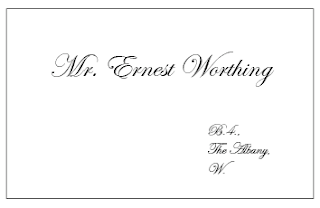 |
| Albany's Ropewalk in 1903 - London' s most secret and most fabulous street (Image source) |
Algernon: Your name isn’t Jack at all; it is Ernest.
Jack: It isn’t Ernest;
it’s Jack.
Algernon: You have always told me it was Ernest. I have introduced you to
everyone as Ernest. You answer to the name of Ernest. You look as if your name
was Ernest. You are the most earnest-looking person I ever saw in my life. It
is perfectly absurd your saying that your name isn’t Ernest. It’s on your
cards. Here is one of them: (Reading: ) ‘Mr
Ernest Worthing, B4, The Albany, W.’
Oh wait, you don't see it marked on the standard street map? That's because it's utterly exclusive. I assure you it exists but you can't always rely on maps: you just need to know it's there. Look again, at this proper old map. It's right there between Sackville Street and Burlington House (or the Royal Academy):
 |
| 1851 map of London, showing Albany nestled in between Piccadilly, Regent Street and Burlington House |
The Albany - or Albany, depending on when you are speaking and how fashionable you are (now, at the beginning of the 21st century, 'Albany', without the definitive article, is de rigeur) - is a series of gentlemen's apartments opening off a private, covered street right in the heart of Mayfair. Albany was created in 1802-03 by the architect Henry Holland, who also built Carlton House, a ridiculously exuberant mansion for the decadent Prince Regent (now sadly demolished). To access the flats (or 'sets', as they are correctly known) of Albany, one passes through what was once Melbourne House, built by the architect Sir William Chambers in 1771-74. Holland also converted this into sets as part of his overall scheme for what is quite possibly the earliest ever example of, let's admit it, bachelor pads - albeit it very, very classy ones.
 |
| c.1830 etching of Albany Courtyard by John Shepherd (Image source) |
Last week, my colleagues and I were granted exclusive access to Albany. We got to stroll in a leisurely fashion down the Ropewalk (as the covered street is known), stop in the tranquil gardens and enjoy a drink with one of the residents in his beautifully proportioned, comfortably sized, perfectly maintained set... Is it a little bit obvious to say that I could definitely live there? Oh, and women are allowed to these days, for the record. Although, I have to confess that the traditionalist/misogynist in me does kind of prefer the idea of some of my more stylish male friends living there to me personally doing so... But the other part of me says 'screw tradition - give me a set!'
 |
| A fine example of a room in one of the sets (Image source) |
As you may well imagine, all sorts of fabulous and famous people have lived at this fabulous and famous address, from poet, Lord Byron, to author, Aldous Huxley, from architect of the British Museum, Robert Smirke, to prime minister, William Gladstone. As a self-confessed Oscar Wilde groupie, however, it is still the fact that Albany appears in Earnest that tickles my fancy most. And so, it was with great pleasure that a very dear friend of mine (the perfect Algy) and myself (a questionable Jack) regaled our gathered workmates with a reading from the play at twilight in the garden of the one and only Albany, concluding with the following confession:
Jack: When one is
placed in the position of guardian one has to
adopt a very high moral tone on all subjects. It’s one's duty to do so. And as a
high moral tone can hardly be said to conduce very much to either one’s health
or one’s happiness if carried to excess, in order to get up to town I have
always pretended to have a younger brother of the name of Ernest, who lives in
the Albany, and gets into the most dreadful scrapes.
 |
| Our stage: one of the gardens at Albany (Image source) |



















